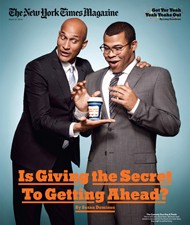Givers, Matchers, Takers

The cover story of the New York Times Magazine this week (“Is Giving the Secret to Getting Ahead?”) takes a look at Adam Grant, the 31-year-old “youngest-tenured and highest-rated professor at Wharton” who has made a career out of studying the benefits of giving (i.e. mentoring a junior colleague) in work environments. Grant practices this kind of giving in his own life, offering to introduce his students to anyone he knows or has met, or helping strangers who email him for advice:
Helpfulness is Grant’s credo. He is the colleague who is always nominating another for an award or taking the time to offer a thoughtful critique or writing a lengthy letter of recommendation for a student — something he does approximately 100 times a year. His largess extends to people he doesn’t even know. A student at Warwick Business School in England recently wrote to express his admiration and to ask Grant how he manages to publish so often, and in such top-tier journals. Grant did not think, upon reading that e-mail, I cannot possibly answer in full every such query and still publish so often, and in such top-tier journals. Instead, Grant, who often returns home after a day of teaching to an in-box of 200 e-mails, responded, “I’m happy to set up a phone call if you want to discuss!”
One of the benefits to giving is pretty simple: We’re more likely to be committed to our work if we know that the people we work with are committed to us. And Grant argues that there’s a strategic way to give without feeling like a doormat. There are givers (people who give without expecting any thing in return), matchers (people who give hoping to get something in return down the line), and takers (people who are happy to receive help but have no intention of paying it forward): “The most successful givers, Grant explains, are those who rate high in concern for others but also in self-interest. And they are strategic in their giving — they give to other givers and matchers, so that their work has the maximum desired effect; they are cautious about giving to takers; they give in ways that reinforce their social ties; and they consolidate their giving into chunks, so that the impact is intense enough to be gratifying.”
Support The Billfold
The Billfold continues to exist thanks to support from our readers. Help us continue to do our work by making a monthly pledge on Patreon or a one-time-only contribution through PayPal.
Comments